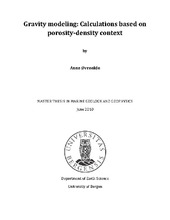| dc.description.abstract | A normal way to model the gravity from a layered model is to determine the densities from the velocities, and then adjusting the densities within acceptable ranges to get a satisfactory fit with the observed gravity. In this thesis the densities are determined from knowledge of lithology and porosity. A grid method is developed, where the 2D earth model is gridded in x- and z-direction, and the density of each grid cell is determined by the lithology and porosity in the cell's four corners. The grid method was tested on some synthetic models, an OBS-line from the Vøring margin and two seismic sections from the Viking Graben in the North Sea. Different scenarios, such as the presence of overpressure, erosion or sill were modeled to test how they affect the gravity field and if their contribution could be significant. The synthetic models show that the grid method gives a more detailed result of the gravity when modeling the sedimentary upper structures than if the modeling is done with constant densities. In the case of overpressure, the value of the gravity decreases above the area of overpressure. A more significant change may happen when erosion in an area is present. The value of gravity increases over the area compared to if erosion was not accounted for. If sill layers are present, the thickness of the sill is often so thin that it will give no significant contribution to the gravity field. The gravity calculated along the OBS-line shows similar trends when using the grid method as using the densities determined from the seismic P-velocities, but there are some local differences. There is however a big gap between the calculated and observed gravity. This can be reduced by correcting the depth to Moho by using Cordell & Henderson's iterative method, and further reduced by changing the density in certain key layers and/or by making the mantle inhomogeneous. The gravity modeled from the two interpreted seismic sections has trends that mainly reflect the varying depth to basement. The depth to Moho was calculated by Cordell & Henderson's method to make a good fit between the observed and calculated gravity and a realistic geometry of the Moho. This method was compared to Airy's isostasy method of calculating the Moho. The Cordell & Henderson's method made a better fit between the observed and calculated gravity, indicating that the crust is not in isostatic equilibrium in the area. Flexural response of the lithosphere due to sediment loading may explain the calculated lateral change in lithostatic pressure below Moho. | en_US |
